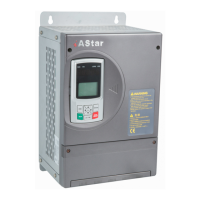
Do you have a question about the STEP iAStar Series and is the answer not in the manual?
Details the application scope and key features of the iAstar Inverter for elevator door machines.
Specifies the recommended environmental conditions for inverter installation and operation.
Provides guidance on the safe and proper disposal of discarded inverters.
Explains the model naming convention and its components for the iAstar inverter.
Presents the technical specifications and performance criteria for the iAstar-S2 inverter model.
Procedure for checking the inverter package contents and condition upon receipt.
Provides the physical dimensions and structural illustrations of the inverter for installation.
Details the requirements for horizontally or vertically mounting the inverter for optimal heat release.
Explains the function and purpose of each terminal on the inverter for main loop and control connections.
Comprehensive listing of function codes, parameter names, ranges, units, and factory settings.
Overview of the hand-held operator's functions, including outline, operation, and fault indication.
Details the panel operator for Type A2/A3, including its outline, keyboard, display, and parameters.
Steps and considerations for debugging encoder control for door width self-learning and accuracy.
Procedure for debugging control terminal wiring and signals to ensure proper inverter operation.
Defines the programmed curves and timing for door opening and closing sequences.
Lists and explains fault codes displayed by the inverter for error analysis.
Provides step-by-step guidance for identifying and resolving inverter faults and common issues.
Daily checks and recording procedures to ensure optimal inverter running ambient and performance.
Scheduled maintenance tasks, including cleaning and bolt checks, to ensure reliable operation.
